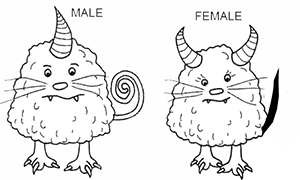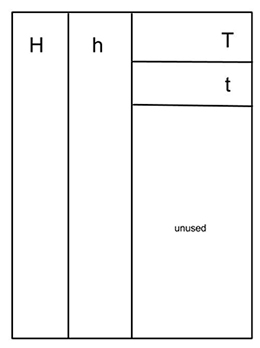Investigation: Modeling Independent Assortment and Dihybrid Crosses

In this activity, you will examine how two traits are inherited in fictional animals called hornmonsters. The genes for these traits are located on separate chromosomes and are inherited according to the following rules.
One horn is dominant to two horns.
Curly tails are dominant to straight tails.
1. For each genotype below, list the phenotype.
HH = __________________________ TT = __________________________
Hh = __________________________ Tt = ___________________________
hh = __________________________ tt = __________________________
2. If you crossed a hornmonster that was homozygous dominant (HHTT) for both traits with one that was homozygous recessive for both traits (hhtt), what is the genotype and phenotype of the offspring?
3. Consider the following cross: H h T t x H h T t
Set up a Punnett square that could be used to determine the ratio of offspring from that cross.
How many offspring will be: 1 Horned, Curly tailed ______ 1 Horned, Straight tailed _______
2 Horned, Curly tailed ______ 2 Horned, Straight tailed _________
II. Modeling Independent Assortment
Why does a Punnett square work? When you put the parent’s genotypes on the top and side of the square, you are showing how each chromosome combines with the other chromosome during the formation of egg and sperm.
For example, some sperm receive an HT combination and other sperm receive and Ht, or hT, or ht The same combinations occur when the female makes eggs.
This principle is called INDEPENDENT ASSORTMENT: or alleles separate during the formation of gametes.
Instructions: (Your instructor may have done this already)
1. Obtain blue paper and cut four strips, two long and two short, as shown in the diagram.

2. Add the alleles to each chromosome. The horn (H) allele is located on the long chromosome and the tail (T) allele is located on the short chromosome.
3. Repeat this process using pink paper to represent the female set of chromosomes.
4. Place your papers face down so that you cannot see what alleles (letters) they carry.
5. Choose a long chromosome from each set randomly (pink and blue).
6. Choose a short chromosome from each set randomly (pink and blue).
7. Flip the papers over to see what genotype your offspring has.
What is your first offspring’s genotype? ___________ What is it’s phenotype? _________________
8. Replace your chromosomes in the original pink and blue set and repeat this process to create 20 offspring. Record your results
III. Analysis
9. Review your data to compile the totals for each phenotype. How many of your offspring were:
1 horn, curly tail ________ 1 horn, straight tail _________
2 horns, curly tail _________ 2 horns, straight tail _________
10. Review your Punnett square from #3 on the first page. How close are your numbers from the crosses you did with paper to what you predicted with a Punnett square? How would you account for any differences?
11. Define independent assortment.
Related Activities
Heredity Simulation - Dihybrid Crosses - Same simulation with one trait
Variations on a Human Face – toss a penny to determine the features of a face, such as freckles, dimples; then draw that face.
Paper Pets – another simulation using paper models with traits for eyes, nose, mouth, and hair.

